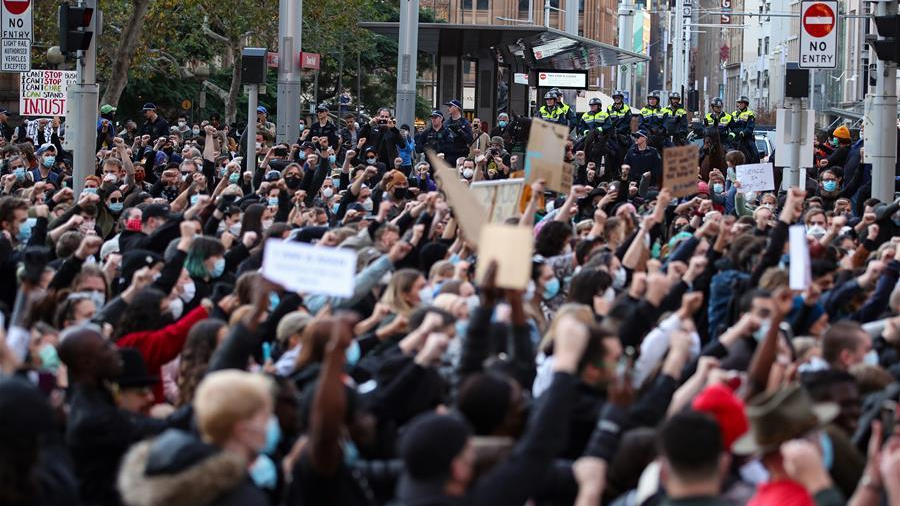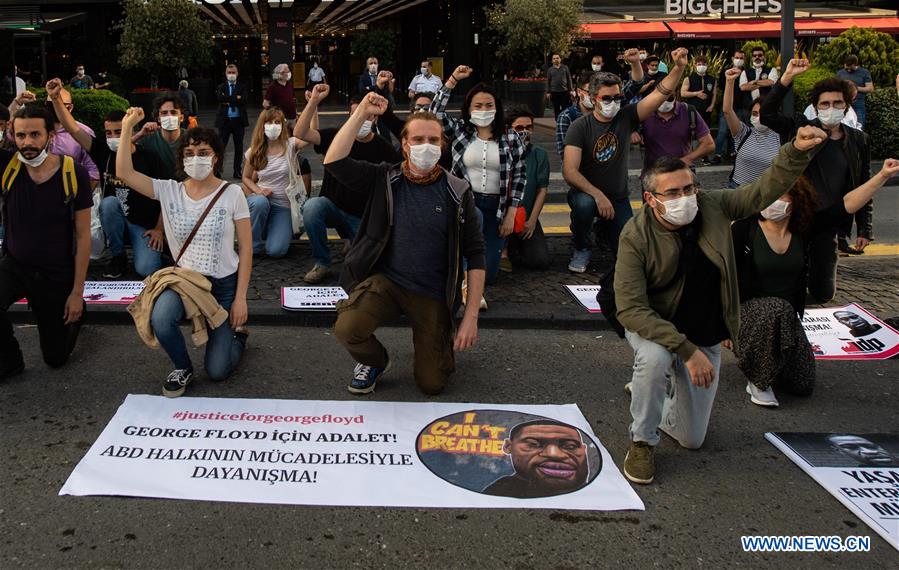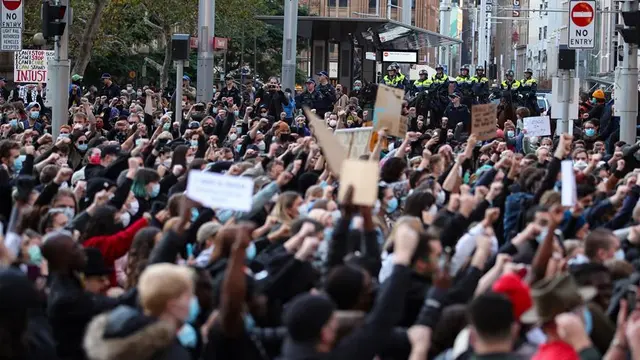
A protest over the death of George Floyd in central Sydney, Australia, June 6, 2020. /Xinhua
**Editor's note: **Mark Hoskin is a doctorate researcher at the School of African and Oriental Studies in theUniversity of London. The article reflects the author's opinions, and not necessarily the views of CGTN.
When a policeman knelt on the neck of African-American George Floyd, he was already handcuffed and submissive according to video footage. Few would have thought back to the National Football League player protests of 2016. President Trump declared Colin Kaepernick's action on taking a knee during the national anthem disrespectful. However, events since May 25 have rocked the nation, and brought into question American ability to maintain the rule of law domestically, as policemen, national guardsmen, and the military fight with protesters, while U.S. President Donald Trump finally got his wall built.
Domestically, while the rioters, looters, and even peaceful protesters, can be held responsible for much of the chaos, it is the actions of the police that show why taking a knee in 2016 should have been given widespread attention.
The actions of officers Robert McCabe and Aaron Torgalski of the Buffalo Police Department in pushing an approaching 75-year-old man, without a head covering to hide his grey hair, to the ground, resulted in an audible crack as his head banged against the concrete, after which his cellphone dropped from his limp hand. Those officers that did try to check on his wellbeing were rapidly moved on. After the officers' suspension was announced, the 57 other tactical unit members resigned in protest, a reaction that symbolized how the police will act to support each other amidst wrongdoing. The two officers have now been charged with second-degree assault.
In Indianapolis, similar acts were carried out by police against protesters who were caught outside during curfew. A young black woman was shoved to the ground, falling in the same position as the 75-year-old man, an act that could have resulted in another American citizen being drastically harmed by those sworn to protect them. Other policemen in the same incident had beaten another woman with their sticks only moments before. These incidents are being repeated across the country.
Internationally, this continual pattern of events is being watched with horror as they paint the U.S. into a corner that will be hard to recover from. The NATO Secretary General Jens Stoltenberg criticized President Trump's use of the military to control protests, telling Sky News that "it's always regarded as an effort of last resort."

A protest against the killing of George Floyd in Istanbul, Turkey, June 5, 2020. /Xinhua
However, the actions of the police and much of their equipment exhibit how deeply embedded the culture of violence against civilians has transferred in a world where the U.S. fights insurgency and militias in endless wars. The point quickly arrived where NPR was reporting it only took until May 29 for two protestors to be killed, yet the presidential response was to use force to clear protestors for a photo shoot.
The waves of violence wrought by endless wars overseas have numbed many Americans to everyday violence on the streets, and make it hard for those who want to see the U.S. continue its post-1945 patterns of behavior overseas to accept that it will be business as usual after the riots stop.
Amidst the rioting and death on America's streets and investigations into the Trump administration, the push to control events overseas continues, although the message is largely lost. The Secretary of State Mike Pompeo has faced investigation for his and his wife's use of government resources. According to NBC News, the former State Department Inspector General Steve Linick was apparently fired for reviewing the Secretary of State's actions. Normally an item that would be on the front pages of newspapers, the announcement that Australian relations with the U.S. could be affected over Victoria's trade relations with other states days afterwards, was perhaps as unsurprising, yet it highlights the desire of this administration to roil newsrooms and deflect attention away from U.S. domestic events.
Internationally, while a statement of this nature over intelligence sharing and infrastructure is unfortunately becoming more unsurprising, news concerning U.S. security activity in Europe was less so.
In a surprise move, on the anniversary of D-Day, perhaps the only exceptional single day in America's armed engagement with the world that all nations can agree on, President Trump announced the approval of U.S. troop withdrawals from Germany. In a continuance of his many complaints over U.S. troop expense and burden sharing globally, this may be seen as a threat to cause other NATO members to increase their contributions to the collective defense umbrella. Unfortunately for President Trump, while these tactics have appeared to shake Asian allies Japan and South Korea, it is less likely the currently damaged economies of European NATO partners will be as pliable.
The result of these Trump administration-led activities, if they are implemented, may be a reduced military footprint overseas, a requirement to spend more money domestically, and a further withdrawal of America from the world stage.
George Floyd's legacy may be that he has caused this administration to speed up or implement plans that were already underway, and at the same time shaken lose the violent foundations of a country that has long held people like him by the neck. Many people around the world would likely say it is about time, yet it didn't occur fast enough to allow George Floyd and others like him to breathe.
(If you want to contribute and have specific expertise, please contact us at [email protected].)
 简体中文
简体中文

